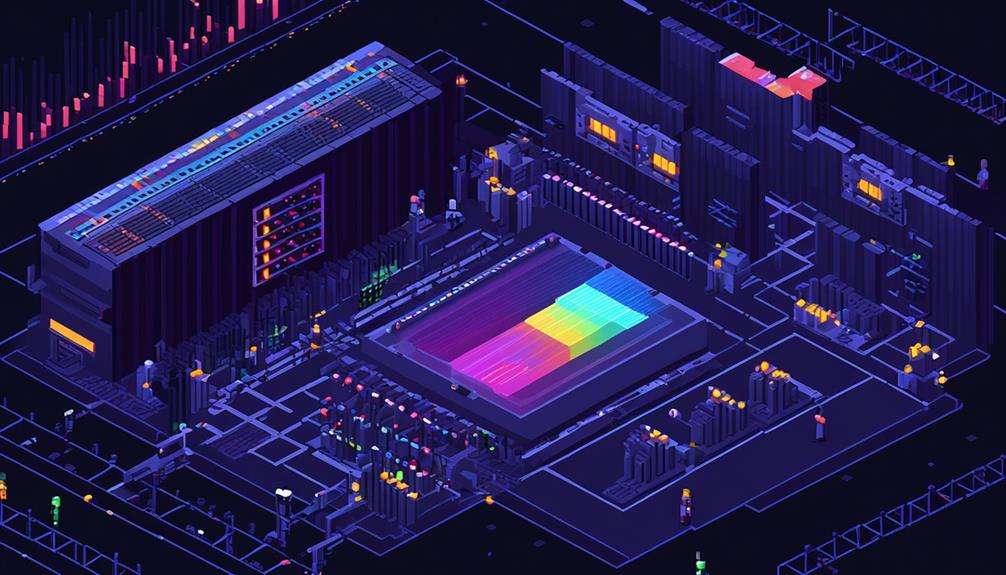Fiber optic amplifiers and repeaters play a crucial role in enhancing the performance and extending the reach of fiber optic networks. These technologies are essential for overcoming the limitations of signal loss and degradation that occur as light travels through optical fibers.
By boosting the optical signals, fiber optic amplifiers amplify the weak signals and ensure their efficient transmission over long distances. Similarly, repeaters regenerate and amplify the signals, compensating for the losses incurred during transmission.
However, the design and optimization of these amplifiers and repeaters pose challenges that require careful consideration. In this discussion, we will explore the technology behind fiber optic amplifiers and repeaters, their significance in long-haul networks, and the challenges and solutions that arise when amplifying fiber optic signals.
Stay tuned to discover the future trends in this critical field of optical communication.
Key Takeaways
- Fiber optic amplifiers prevent signal attenuation in optical fibers.
- Amplifiers directly amplify optical signals without converting them to electrical form.
- Repeaters compensate for factors such as attenuation, dispersion, and noise in fiber optic networks.
- Amplifiers and repeaters are crucial for maintaining signal integrity and improving the reliability of long-distance optical communication.
What Are Fiber Optic Amplifiers?

A fiber optic amplifier is a vital component in long-distance optical communication systems, ensuring the detection and transmission of optical signals over extended distances by preventing signal attenuation caused by low transmission loss in optical fibers.
Optical signals, when transmitted over long distances in fiber optic networks, experience a loss in signal strength due to the inherent properties of the fiber, such as scattering and absorption. This loss of signal strength can lead to degraded signal quality and ultimately make it difficult to detect and interpret the transmitted information.
To overcome this challenge, fiber amplifiers are employed. These devices directly amplify the optical signals without converting them to electrical form, which allows for cost-effective and efficient signal transmission over long distances. By boosting the power of the optical signals, fiber amplifiers compensate for the signal attenuation and ensure that the transmitted signals remain strong and clear.
There are various types of fiber amplifiers, including erbium-doped fiber amplifiers (EDFAs) and Raman amplifiers. EDFAs are the most commonly used type of fiber amplifier and operate by utilizing the properties of erbium-doped optical fibers to amplify the optical signals. Raman amplifiers, on the other hand, rely on the Raman effect to amplify the signals.
Fiber amplifiers offer several advantages over traditional electro-optical repeaters/regenerators. They are simpler and less costly, as they eliminate the need for converting optical signals to electrical form and back again. Additionally, fiber amplifiers do not introduce signal distortion or interruption in communication, making them more reliable for long-distance optical transmission.
Understanding the Role of Repeaters
Repeaters play a crucial role in fiber optic communication systems by amplifying optical signals to overcome signal degradation and extend transmission distances. By boosting the signal strength, repeaters ensure that the signal can travel long distances without losing its quality.
Additionally, repeaters help overcome signal degradation caused by factors such as attenuation, dispersion, and noise, thereby improving the overall reliability and performance of the communication system.
Amplification for Signal Strength
The amplification of signal strength is a critical aspect in long haul applications, where repeaters play a crucial role in removing signal distortion and increasing the signal level. There are two basic approaches to repeaters: electro-optical repeaters/regenerators and optical amplifiers. Optical amplifiers directly amplify optical signals without converting them to electrical form, offering a simpler and cost-effective alternative to electro-optical repeaters. Optical amplifiers are widely used in various industries to maintain signal integrity and quality over long-haul applications. They provide high gain and can amplify multiple wavelengths simultaneously. The use of optical amplifiers eliminates the need for costly and complex electro-optical conversions, reducing potential failure points and the need for continuous monitoring. Overall, optical amplifiers are an essential tool for enhancing signal strength in fiber optic communication systems.
| Optical Amplifiers |
|---|
| – Directly amplify optical signals |
| – Simpler and cost-effective alternative to electro-optical repeaters |
| – Provide high gain |
| – Amplify multiple wavelengths simultaneously |
Extending Transmission Distance
Extending the transmission distance in fiber optic communication systems requires a comprehensive understanding of the crucial role that repeaters play.
Repeaters, also known as line amplifiers, are essential for removing signal distortion and increasing signal level in long-haul applications. There are two basic approaches for repeaters: electro-optical repeaters/regenerators and optical amplifiers.
Optical amplifiers directly amplify optical signals without converting them to electrical form, offering cost-effective and noise-reducing benefits. However, using repeaters comes with challenges such as cost, complexity, continuous monitoring, careful spacing requirements, and potential interruptions in communication.
Nevertheless, fiber optic amplifiers and repeaters are indispensable for maintaining signal integrity and enabling reliable communication in various industries.
Effectively extending transmission distance in fiber optic communication systems.
Overcoming Signal Degradation
To ensure signal integrity and reliable communication in fiber optic communication systems, it is crucial to understand the role of repeaters in overcoming signal degradation. Repeaters, also known as line amplifiers, are strategically installed at intervals in long haul applications to remove signal distortion and increase signal level.
There are two basic approaches to repeaters: electro-optical repeaters/regenerators and optical amplifiers.
- Electro-optical repeaters: These repeaters convert optical signals to electrical signals, amplify them, and then convert them back to optical signals. This process helps to regenerate and strengthen the weak signals, ensuring their integrity throughout the transmission.
- Optical amplifiers: Unlike electro-optical repeaters, optical amplifiers directly amplify optical signals without converting them to electrical form. They can be spaced more closely, reducing noise and enabling transmission over thousands of kilometers.
Importance of Signal Enhancement in Fiber Optic Networks
Why is signal enhancement crucial in fiber optic networks?
Signal enhancement plays a vital role in maintaining the integrity and quality of optical signals transmitted through fiber optic networks. As signals travel over long distances, they experience degradation due to factors such as attenuation and dispersion. To overcome these challenges and ensure reliable data transmission, signal enhancement techniques are employed.
Optical amplifiers are key components in signal enhancement in fiber optic networks. Unlike traditional electro-optical repeaters that convert optical signals into electrical form for amplification, optical amplifiers directly amplify the optical signals. This eliminates the need for costly and complex conversion processes, making it a more efficient and cost-effective solution. Additionally, optical amplifiers can be placed more closely together along the fiber, reducing noise and enabling transmission over thousands of kilometers.
One significant advancement in optical amplifiers is the Erbium-Doped Fiber Amplifier (EDFA). EDFAs use erbium-doped fibers to amplify optical signals without converting them to electrical signals. This approach increases the data transfer speed and improves the overall performance of the network.
In addition to optical amplifiers, all-optical regenerators also contribute to signal enhancement in fiber optic networks. These regenerators, such as non-linear optical fibers, provide a power-efficient method of regeneration without the need for optical-to-electrical conversion. By operating at the optical level, these regenerators help maintain signal integrity and minimize signal degradation.
How Amplifiers Extend the Reach of Fiber Optic Networks

Signal enhancement techniques, such as optical amplifiers and regenerators, play a crucial role in extending the reach of fiber optic networks by maintaining signal integrity and minimizing degradation over long distances. Amplifiers are essential components that amplify optical signals directly without converting them to electrical form, simplifying the process and reducing costs.
Here is how amplifiers extend the reach of fiber optic networks:
- Increased transmission distance: Optical amplifiers allow for the transmission of signals over thousands of kilometers without significant degradation. By amplifying the optical signal directly, the need for frequent signal regeneration or conversion to electrical form is eliminated, resulting in a more efficient and cost-effective solution.
- Reduced noise and improved signal quality: Optical amplifiers can be spaced more closely along the fiber optic network, reducing the impact of noise and signal degradation. This allows for better signal quality and higher transmission speeds over longer distances.
In addition to these benefits, optical amplifiers also offer advantages over traditional repeaters. Repeaters are costly, complex, and prone to failure, requiring continuous monitoring and careful spacing to maintain signal quality. On the other hand, optical amplifiers are a more reliable and cost-effective alternative, making them suitable for various industries such as telecommunications, broadcasting, and CATV networks.
One example of an optical amplifier is the erbium-doped fiber amplifier (EDFA), which is an all-optical repeater. EDFAs eliminate the need for signal conversion, increasing data transfer speed and power efficiency. These amplifiers have become a critical component in long-distance optical communication systems, enabling the expansion and enhancement of fiber optic networks.
Exploring the Technology Behind Fiber Optic Repeaters
Fiber optic repeaters are crucial components in long-haul applications, providing signal amplification and distortion removal at intervals along the fiber optic network. There are two basic approaches to fiber optic repeaters: electro-optical repeaters/regenerators and optical amplifiers.
Electro-optical repeaters convert the optical signal into electrical form, regenerate it, and then convert it back into an optical signal. On the other hand, optical amplifiers directly amplify optical signals without converting them to electrical form, making them simpler and less costly compared to electro-optical repeaters.
Optical amplifiers have revolutionized long-haul fiber optic communication by enabling signals to be amplified without the need for costly and complex regeneration processes. They are typically based on erbium-doped fiber amplifiers (EDFAs), which use a length of optical fiber doped with erbium ions. When a pump laser is applied to the doped fiber, the erbium ions become excited and can amplify the optical signal passing through the fiber.
One of the main advantages of optical amplifiers is their ability to amplify multiple wavelengths simultaneously, allowing for wavelength-division multiplexing (WDM) and the transmission of multiple signals over a single fiber. This significantly increases the capacity and efficiency of the fiber optic network.
However, challenges with repeaters include their cost, complexity, and potential failure, which require continuous monitoring and careful spacing for installation. Despite these challenges, fiber optic amplifiers and repeaters are essential for maintaining signal integrity and quality over long distances, enabling reliable and efficient communication in various industries such as telecommunications, broadcasting, and CATV networks.
Different Types of Fiber Optic Amplifiers

When it comes to different types of fiber optic amplifiers, there are a few key points to consider.
Firstly, amplification techniques play a crucial role in enhancing the strength of optical signals without the need for electrical conversion.
Additionally, signal regeneration is an important aspect that allows for efficient data transfer and increased transmission speeds.
Amplification Techniques
Different types of fiber optic amplifiers, such as electro-optical repeaters and optical amplifiers, play a crucial role in enhancing the performance of optical communication systems.
Here are two main amplification techniques used in fiber optic communication:
- Electro-optical repeaters/regenerators: These devices convert optical signals to electrical signals, amplify them, and then convert them back to optical signals. They are commonly used in long-haul transmission systems to compensate for signal loss and maintain signal integrity.
- Optical amplifiers: Unlike electro-optical repeaters, optical amplifiers directly amplify optical signals without converting them to electrical form. This simplifies the amplification process and reduces cost. Erbium-Doped Fiber Amplifiers (EDFAs) are examples of all-optical repeaters that amplify the signal without converting it to an electrical signal.
Signal Regeneration
Signal regeneration in fiber optic communication systems can be achieved through various types of amplifiers.
There are two primary approaches to signal regeneration: electro-optical repeaters and optical amplifiers.
Electro-optical repeaters convert optical signals to electrical form, amplify them, and then convert them back to optical signals.
On the other hand, optical amplifiers directly amplify optical signals without the need for conversion to electrical form. This makes optical amplifiers simpler and less costly than electro-optical repeaters.
Additionally, there are all-optical regenerators that utilize non-linear optical fibers to achieve signal regeneration without the requirement of converting signals between optical and electronic forms.
These different types of amplifiers play a crucial role in maintaining the strength and quality of optical signals in fiber optic communication systems.
Benefits of Using Repeaters in Telecommunications
Using repeaters in telecommunications allows for the removal of signal distortion and an increase in signal level at intervals, ensuring reliable and efficient communication over long-haul applications in fiber optic networks. Here are some benefits of using repeaters in telecommunications:
- Maintaining Signal Integrity: Repeaters help in maintaining signal integrity and quality over long-haul applications. By amplifying the signal periodically, repeaters ensure that the signal remains strong and clear, reducing the chances of signal degradation or loss.
- Cost-Effective Transmission: The installation of repeaters at intervals allows for the transmission of signals over maximum permitted distances between transmitters and receivers. This enables cost-effective transmission of signals over thousands of kilometers, making it essential for long-distance optical communication systems.
- Extending Transmission Distance: Repeaters combat the loss of signal power in fiber optic cables, allowing for the transmission of signals over longer distances without the need for reamplification. This eliminates the need for additional costly equipment and simplifies the communication infrastructure.
- Improved Reliability: By boosting the signal periodically, repeaters enhance the reliability of communication in fiber optic networks. They compensate for signal attenuation and ensure that the signal remains strong and reliable throughout the transmission, reducing the chances of data loss or interruptions.
- Efficient Network Design: The use of repeaters enables more efficient network design by extending the reach of the fiber optic network. This flexibility allows for the optimization of network routes and the ability to connect distant locations, making it easier to expand and scale the network as needed.
Amplifiers Vs. Repeaters: Key Differences and Similarities

Amplifiers and repeaters play crucial roles in long-distance optical communication systems, but they differ in their approach to signal amplification and conversion. Optical amplifiers directly amplify optical signals without converting them to electrical form, while electro-optical repeaters convert optical signals to electrical signals, amplify them, and convert them back to optical signals.
To better understand the differences and similarities between amplifiers and repeaters, let's explore them in a table format:
| Amplifiers | Repeaters | |
|---|---|---|
| Approach to Signal Amplification | Directly amplify optical signals | Convert optical signals to electrical signals, amplify, and convert back to optical signals |
| Complexity | Simple | Complex |
| Cost | Less costly | Costly |
| Installation Spacing | Can be spaced more closely | Require careful spacing |
| Noise | Reduce noise due to close spacing | Prone to noise |
| Reliability | Generally reliable | Require continuous monitoring and prone to failure |
Amplifiers, being simpler and less costly, are often preferred over repeaters. They can be placed more closely together, reducing noise and allowing transmission over thousands of kilometers. On the other hand, repeaters are costly, complex, and require continuous monitoring to maintain signal quality.
However, repeaters have their advantages as well. They can convert signals to electrical form, allowing for amplification in that domain, which can be beneficial in certain scenarios. Additionally, all-optical repeaters, such as erbium-doped fiber amplifiers (EDFAs), eliminate the need for signal conversion, leading to increased data transfer speed and efficiency in fiber optic communication systems.
Factors to Consider When Choosing Fiber Optic Amplifiers
When selecting fiber optic amplifiers, it is essential to consider various factors that contribute to signal integrity, cost efficiency, noise reduction, compatibility, and future expansion capabilities. To ensure the best performance and value for your fiber optic network, keep the following factors in mind:
Signal Quality:
- Evaluate the amplifier's ability to maintain signal integrity and quality over long distances. Look for low signal degradation and high gain to minimize loss and distortion.
- Consider the amplifier's bandwidth and dispersion characteristics to ensure it can handle the specific requirements of your network.
Cost Efficiency:
- Compare the cost-effectiveness of fiber optic amplifiers to repeater systems. Consider both the initial investment and maintenance costs over the long term.
- Look for amplifiers that offer a good balance between performance and affordability, avoiding over-engineered solutions that may be unnecessary for your network.
Noise Reduction:
- Choose amplifiers with features designed to minimize noise and signal distortion. Look for technologies like erbium-doped fiber amplifiers (EDFAs) that provide low noise figures.
- Consider the amplifier's dynamic range and its ability to handle a wide range of input power levels without introducing additional noise.
Compatibility:
- Ensure that the amplifier is compatible with your specific fiber optic network. Consider factors such as wavelength range, transmission distance, and the types of fiber and connectors used.
- Check for industry standards compliance to ensure interoperability with other network components.
Future Expansion:
- Consider the potential for scalability and future network growth when selecting an amplifier. Look for features like modular designs or the ability to cascade multiple amplifiers to accommodate evolving communication needs.
- Evaluate the amplifier's flexibility in terms of supporting different transmission speeds and protocols.
The Role of Repeaters in Ensuring Data Integrity

Repeating devices, such as line amplifiers or regenerators, play a crucial role in maintaining data integrity over long distances in fiber optic networks. These repeaters are essential in long haul applications as they remove signal distortion and increase signal level, ensuring the integrity of data transmission.
There are two main types of repeaters: electro-optical repeaters/regenerators and optical amplifiers. Electro-optical repeaters regenerate the optical signal by converting it to an electrical signal, amplifying it, and then converting it back to an optical signal. This process helps eliminate signal distortion and restore the original signal quality. On the other hand, optical amplifiers amplify the optical signal directly without converting it to an electrical signal. Optical amplifiers use specialized materials, such as erbium-doped fiber, to amplify the signal, ensuring its integrity over long distances.
However, repeaters do come with challenges. They can be costly to implement, adding to the network owner's expenses. Repeater installations can also be complex, requiring careful planning and coordination. Additionally, repeaters require continuous monitoring to ensure they are functioning correctly, which further increases operational costs.
Despite these challenges, fiber optic amplifiers and repeaters are crucial for maintaining the integrity and quality of signals over long-haul applications, especially in industries such as telecommunications, broadcasting, and CATV networks. They combat the loss of signal power in fiber optic cables by amplifying the depleted signal. It is important to note that while repeaters amplify the signal, they may potentially slow down the rate of data transfer. Therefore, network designers must carefully consider the placement and number of repeaters to balance signal integrity and transmission speed.
Amplifiers and Repeaters in Long-Haul Fiber Optic Networks
To ensure the integrity of data transmission over long distances in fiber optic networks, the use of amplifiers and repeaters is imperative. Optical fibers have low transmission loss, making long-distance signal transmission possible. However, signal degradation can occur due to factors such as attenuation, dispersion, and noise. Amplification of optical signals is essential to maintain signal integrity over long-haul applications.
Amplifiers and repeaters play a crucial role in long-haul fiber optic networks. Here are two key aspects of their importance:
- Signal Distortion Removal:
- Repeaters and line amplifiers are strategically placed at intervals along the fiber optic network to remove signal distortion. These devices regenerate the optical signal, restoring it to its original quality.
- Signal distortion can occur due to factors like attenuation, which causes the signal strength to decrease over distance, and dispersion, which causes the signal to spread out and blur. Amplifiers and repeaters counteract these effects, ensuring that the signal remains strong and clear throughout the network.
- Signal Level Enhancement:
- In addition to removing signal distortion, amplifiers and repeaters also increase the signal level. This is important because as the signal travels over long distances, it tends to weaken.
- By boosting the signal strength, these devices ensure that the signal can reach its destination without any loss of information. This helps maintain a high signal-to-noise ratio, minimizing errors and maximizing data transmission efficiency.
In long-haul fiber optic networks, amplifiers and repeaters are essential components for maintaining signal integrity and enabling reliable data transmission over extended distances. Their strategic placement and ability to remove signal distortion and enhance signal strength make them crucial for ensuring optimal network performance.
Enhancing Network Performance With Fiber Optic Amplifiers

Fiber optic amplifiers play a crucial role in enhancing the performance of network communication. They boost signal strength and maintain signal integrity over long distances. Fiber optic amplifiers offer a simpler and less costly solution compared to electro-optical repeaters. This makes them an essential component in long-distance optical communication systems used across various industries such as telecommunications, broadcasting, and CATV networks.
One type of fiber optic amplifier commonly used is the Erbium-Doped Fiber Amplifier (EDFA). EDFAs are all-optical repeaters that amplify signals without the need for conversion to electrical signals. This results in increased data transfer speed. By amplifying the optical signals directly, EDFAs enhance the network performance by reducing the need for frequent signal regeneration.
In addition to amplifiers, fiber repeaters also contribute to enhancing network performance. They combat the loss of signal power in fiber optic cables, allowing for the extension of Ethernet data signals over multimode or single-mode fiber up to 160km (100 miles). Fiber repeaters boost the signal strength, maintaining the integrity of the transmitted data and ensuring reliable and efficient network communication.
Challenges and Solutions in Amplifying Fiber Optic Signals
Amplifying fiber optic signals presents significant challenges in maintaining signal integrity and minimizing signal distortion, noise, and loss over long distances. However, there are solutions available to address these challenges and ensure efficient signal transmission.
Here are some of the challenges and their corresponding solutions:
- Signal Distortion and Noise:
- Challenge: As the signal travels through the fiber optic cable, it can experience distortion and noise, which can degrade the quality of the signal.
- Solution: Optical amplifiers can be used to directly amplify the optical signals without converting them to electrical form. This helps in reducing noise and maintaining signal integrity.
- Signal Loss over Long Distances:
- Challenge: Optical signals can experience significant loss as they travel over long distances due to fiber attenuation.
- Solution: By using optical amplifiers, the signals can be amplified periodically along the transmission path. This allows for longer transmission distances without significant loss.
In addition to the challenges mentioned above, the use of repeaters can also introduce complexity and cost. While repeaters are effective in amplifying signals, they require careful spacing and continuous monitoring to prevent failure. To mitigate the impact of repeaters on signal speed, improving cable quality and repeater quality can be beneficial.
Future Trends in Fiber Optic Amplifiers and Repeaters

Advancements in optical communication systems are driving future trends in fiber optic amplifiers and repeaters. The demand for faster and more reliable data transfer over long distances has led to research and development in improving the signal quality and reliability of fiber optic communication systems. One of the key trends in the future is the use of all-optical repeaters, such as erbium-doped fiber amplifiers (EDFAs), which eliminate the need for signal conversion and increase data transfer speed.
To provide a clearer picture of the future trends in fiber optic amplifiers and repeaters, the following table summarizes the key advancements:
| Future Trends in Fiber Optic Amplifiers and Repeaters |
|---|
| – Filling available bandwidth with usable fiber amplifier technology |
| – Supporting Dense Wavelength Division Multiplexing (DWDM) |
| – Expanding to other wavelength bands |
| – Focus on cost efficiency, power efficiency, and signal integrity |
| – Improving link and data transmission integrity |
The future trends in fiber optic amplifiers and repeaters aim to maximize the potential of optical fibers by utilizing the available bandwidth effectively. This includes developing fiber amplifier technology that can support Dense Wavelength Division Multiplexing (DWDM), allowing multiple wavelengths to be transmitted simultaneously over a single fiber. Furthermore, research is being conducted to expand the use of fiber amplifiers to other wavelength bands, enabling even greater data transfer speeds.
Another important aspect of future trends is the focus on cost efficiency, power efficiency, and signal integrity. As the demand for fiber optic communication systems increases, there is a need for more cost-effective and energy-efficient solutions. Additionally, ensuring signal integrity is crucial to maintain the reliability and quality of data transmission.
Frequently Asked Questions
Do Fiber Optics Need Repeaters?
Fiber optics require repeaters to compensate for signal loss over long distances. Due to the inherent characteristics of fiber optic cables, such as attenuation and dispersion, signals can become too faint to detect without amplification.
Repeaters serve the purpose of regenerating and amplifying the signals, ensuring their integrity and strength throughout the transmission. Without repeaters, the quality and reliability of fiber optic communication would be compromised, resulting in degraded performance and limited reach.
What Are Repeaters in Optical Fiber?
Signal regeneration is a critical process in maintaining the integrity and quality of optical fiber communication over long distances. Repeater technology plays a vital role in achieving this by amplifying optical signals and removing signal distortion.
In essence, repeaters act as intermediaries by receiving weak optical signals, boosting their strength, and retransmitting them along the fiber optic cable. This ensures that the signal remains strong and clear, enabling reliable long-haul communication in industries such as telecommunications, broadcasting, and CATV networks.
Do Fiber Optic Cables Need Amplifiers?
Fiber optic cables do not inherently require amplifiers, but they may be necessary in certain situations.
Fiber optic cables are designed to transmit light signals over long distances without significant degradation or loss. However, as the signal travels through the cable, it can weaken and become too faint to be detected accurately.
In such cases, fiber optic amplifiers can be used to boost the signal strength, ensuring reliable transmission over longer distances. Amplifiers help maintain the integrity and quality of the fiber optic signal, improving overall performance.
How Is an Optical Amplifier Different From a Repeater?
An optical amplifier differs from a repeater in that it does not regenerate the signal it amplifies. Instead, it amplifies both the signal and the noise, making it a cost-effective solution for fiber optic systems.
In contrast, a repeater converts optical signals to electrical signals, amplifies them, and then converts them back to optical signals. This process allows for signal regeneration and ensures uninterrupted communication.
However, repeaters are costly, complex, and require continuous monitoring, while optical amplifiers are simpler, more cost-effective, and can be spaced closely, reducing noise.

